Articles
- Page Path
- HOME > J Korean Acad Nurs > Volume 41(6); 2011 > Article
-
Original Article
- Effect of DHEA on Recovery of Muscle Atrophy Induced by Parkinson's Disease
- Myoung-Ae Choe, Gyeong Ju An, Byung-Soo Koo, Songhee Jeon
-
Journal of Korean Academy of Nursing 2011;41(6):834-842.
DOI: https://doi.org/10.4040/jkan.2011.41.6.834
Published online: December 31, 2011
1Professor, College of Nursing, Seoul National University, Seoul, Korea.
2Assistant Professor, Department of Nursing, Cheongju University, Cheongju, Korea.
3Professor, Department of Neuropsychiatry, Graduate School of Oriental Medicine, Dongguk University, Gyeongju, Korea.
4Assistant Professor, Dongguk University Research Institute of Biotechnology, Seoul, Korea.
- Address reprint requests to: Jeon, Songhee. Dongguk University Research Institute of Biotechnology, 27-3 Phil-dong 3, Jung-gu, Seoul 100-715, Korea. Tel: +82-2-2260-8535, Fax: +82-2-2271-3489, jsong0304@dongguk.edu
© 2011 Korean Society of Nursing Science
- 991 Views
- 1 Download
- 6 Crossref
Abstract
-
Purpose
- The purpose of this study was to determine the effect of dehydroepiandrosterone (DHEA) on recovery of muscle atrophy induced by Parkinson's disease.
-
Methods
- The rat model was established by direct injection of 6-hydroxydopamine (6-OHDA, 20 µg) into the left striatum using stereotaxic surgery. Rats were divided into two groups; the Parkinson's disease group with vehicle treatment (Vehicle; n=12) or DHEA treatment group (DHEA; n=22). DHEA or vehicle was administrated intraperitoneally daily at a dose of 0.34 mmol/kg for 21 days. At 22-days after DHEA treatment, soleus, plantaris, and striatum were dissected.
-
Results
- The DHEA group showed significant increase (p<.01) in the number of tyrosine hydroxylase (TH) positive neurons in the lesioned side substantia nigra compared to the vehicle group. Weights and Type I fiber cross-sectional areas of the contralateral soleus of the DHEA group were significantly greater than those of the vehicle group (p=.02, p=.00). Moreover, extracellular signal-regulated kinase (ERK) phosphorylation significantly decreased in the lesioned striatum, but was recovered with DHEA and also in the contralateral soleus muscle, Akt and ERK phosphorylation recovered significantly and the expression level of myosin heavy chain also recovered by DHEA treatment.
-
Conclusion
- Our results suggest that DHEA treatment recovers Parkinson's disease induced contralateral soleus muscle atrophy through Akt and ERK phosphorylation.
INTRODUCTION
METHODS
1) Induction of Parkinson's disease
2) DHEA treatment
1) Body weight
2) Food intake
3) Activity
4) Muscle weight
5) Cross-sectional area of Type I and II fibers.
6) Tyrosine Hydroxylase (TH) expression by Immunohistochemistry
7) Protein expression and phosphorylation by Western blot analysis
RESULTS
DISCUSSION
CONCLUSION
This research was supported by Basic Science Research Program through the National Research Foundation of Korea (NRF) funded by the Ministry of Education, Science and Technology (810-20090016).
- 1. American College of Sports Medicine. ACSM's advanced exercise physiology. 2006;Philadelphia, Lippincott Williams & Wilkins.
- 2. Bárány M. ATPase activity of myosin correlated with speed of muscle shortening. The Journal of General Physiology. 1967;50:197–218.ArticlePMCPDF
- 3. Bélanger N, Grégoire L, Bédard P, Di Paolo T. Estradiol and dehydroepiandrosterone potentiate levodopa-induced locomotor activity in 1-methyl-4-phenyl-1,2,3,6-tetrahydropyridine monkeys. Endocrine. 2003;21:97–101.ArticlePubMed
- 4. Bergeron R, de Montigny C, Debonnel G. Potentiation of neuronal NMDA response induced by dehydroepiandrosterone and its suppression by progesterone: Effects mediated via sigma receptors. Journal of Neuroscience. 1996;16:1193–1202.ArticlePubMed
- 5. Bigard XA, Janmot C, Merino D, Lienhard F, Guezennec YC, D'Albis A. Endurance training affects myosin heavy chain phenotype in regenerating fast-twitch muscle. Journal of Applied Physiology. 1996;81:2658–2665.ArticlePubMed
- 6. Brown GA, Vukovich MD, Sharp RL, Reifenrath TA, Parsons KA, King DS. Effect of oral DHEA on serum testosterone and adaptations to resistance training in young men. Journal of Applied Physiology. 1999;87:2274–2283.ArticlePubMed
- 7. Cano-de-la-Cuerda R, Pérez-de-Heredia M, Miangolarra-Page JC, Muñoz-Hellín E, Fernández-de-Las-Peñas C. Is there muscular weakness in Parkinson's disease? American Journal of Physical Medicine and Rehabilitation. 2010;89:70–76.ArticlePubMed
- 8. Choe MA, An GJ. Effect of DHEA administration alone or exercise combined with DHEA before steroid treatment on rat hindlimb muscles. Journal of Korean Academy of Nursing. 2009;39:321–328.ArticlePubMed
- 9. Choe MA, An GJ, Lee YK, Im JH, Choi-Kwon S, Heitkemper M. Effect of inactivity and undernutrition after acute ischemic stroke in a rat hindlimb muscle model. Nursing Research. 2004;53:283–292.ArticlePubMed
- 10. Cyr M, Calon F, Morissette M, Grandbois M, Di Paolo T, Callier S. Drugs with estrogen-like potency and brain activity: Potential therapeutic application for the CNS. Current Pharmaceutical Design. 2000;6:1287–1312.ArticlePubMed
- 11. Frimel TN, Kapadia F, Gaidosh GS, Li Y, Walter GA, Vandenborne K. A model of muscle atrophy using cast immobilization in mice. Muscle and Nerve. 2005;32:672–674.ArticlePubMed
- 12. Fryburg DA, Jahn LA, Hill SA, Oliveras DM, Barrett EJ. Insulin and insulin-like growth factor-I enhance human skeletal muscle protein anabolism during hyperaminoacidemia by different mechanisms. Journal of Clinical Investigation. 1995;96:1722–1729.ArticlePubMedPMC
- 13. Garcia-Segura LM, Azcoitia I, DonCarlos LL. Neuroprotection by estradiol. Progress in Neurobiology. 2001;63:29–60.ArticlePubMed
- 14. Harris DS, Wolkowitz OM, Reus VI. Movement disorder, memory, psychiatric symptoms and serum DHEA levels in schizophrenic and schizoaffective patients. World Journal of Biological Psychiatry. 2001;2:99–102.Article
- 15. Hornykiewicz O. Ageing and neurotoxins as causative factors in idiopathic Parkinson’s disease-a critical analysis of the neurochemical evidence. Progress in Neuro-psychopharmacology and Biological Psychiatry. 1989;13(3):19–328.
- 16. Kalimi M, Shafagoj Y, Loria R, Padgett D, Regelson W. Anti-glucocorticoid effects of dehydroepiandrosterone (DHEA). Molecular and Cellular Biochemistry. 1994;131:99–104.ArticlePubMedPDF
- 17. Kim Y, Choe MA. Effect of decreased locomotor activity on hindlimb muscles in a rat model of Parkinson's disease. Journal of Korean Academy of Nursing. 2010;40:580–588.ArticlePubMed
- 18. Leskiewicz M, Regulska M, Budziszewska B, Jantas D, Jaworska-Feil L, Basta-Kaim A, et al. Effects of neurosteroids on hydrogen peroxide- and staurosporine-induced damage of human neuroblastoma SH-SY5Y cells. Journal of Neuroscience Research. 2008;86:1361–1370.ArticlePubMed
- 19. Maninger N, Wolkowitz OM, Reus VI, Epel ES, Mellon SH. Neurobiological and neuropsychiatric effects of dehydroepiandrosterone (DHEA) and DHEA sulfate (DHEAS). Frontiers in Neuroendocrinology. 2009;30:65–91.ArticlePubMed
- 20. Mehta AK, Ticku MK. Unsulfated and sulfated neurosteroids differentially modulate the binding characteristics of various radioligands of GABA(A) receptors following chronic ethanol administration. Neuropharmacology. 2001;40:668–675.ArticlePubMed
- 21. Mhyre AJ, Dorsa DM. Estrogen activates rapid signaling in the brain: Role of estrogen receptor alpha and estrogen receptor beta in neurons and glia. Neuroscience. 2006;138:851–858.ArticlePubMed
- 22. Mitoma H, Hayashi R, Yanagisawa N, Tsukagoshi H. Characteristics of parkinsonian and ataxic gaits: A study using surface electromyograms, angular displacements and floor reaction forces. Journal of the Neurological Sciences. 2000;174:22–39.ArticlePubMed
- 23. Morales AJ, Haubrich RH, Hwang JY, Asakura H, Yen SS. The effect of six months treatment with a 100mg daily dose of DHEA on circulating sex steroids, body composition and muscle strength in age-advanced men and women. Journal of Clinical Endocrinology and Metabolism. 1998;78:1360–1367.
- 24. Morris ME, Iansek R, Matyas TA, Summers JJ. The pathogenesis of gait hypokinesia in Parkinson's disease. Brain. 1994;117:1169–1181.ArticlePubMed
- 25. Muir GD, Whishaw IQ. Ground reaction forces in locomoting hemi-parkinsonian rats: A definitive test for impairments and compensations. Experimental Brain Research. 1999;126:307–314.ArticlePubMedPDF
- 26. Schwarting RK, Huston JP. The unilateral 6-hydroxydopamine lesion model in behavioral brain research. Analysis of functional deficits, recovery and treatments. Progress in Neurobiology. 1996;50:275–331.ArticlePubMed
- 27. Sugino M, Ohsawa N, Ito T, Ishida S, Yamasaki H, Kimura F, Shinoda K. A pilot study of dehydroepiandrosterone sulfate in myotonic dystrophy. Neurology. 1998;51:586–589.ArticlePubMed
- 28. Weill-Engerer S, David JP, Sazdovitch V, Liere P, Schumacher M, Delacourte A, et al. In vitro metabolism of dehydroepiandrosterone (DHEA) to 7alpha-hydroxy-DHEA and delta5-androstene-3beta, 17beta-diol in specific regions of the aging brain from Alzheimer's and non-demented patients. Brain Research. 2003;969:117–125.ArticlePubMed
- 29. Whishaw IQ, Suchowersky O, Davis L, Sarna J, Metz GA, Pellis SM. Impairment of pronation, supination, and body co-ordination in reach-to-grasp tasks in human Parkinson's disease (PD) reveals homology to deficits in animal models. Behavioural Brain Research. 2002;133:165–176.ArticlePubMed
- 30. Yen S, Morales A, Khorram O. Replacement of DHEA in aging men and women: Potential remedial effects. Annals of the New York Academy of Sciences. 1995;774:128–142.ArticlePubMed
REFERENCES
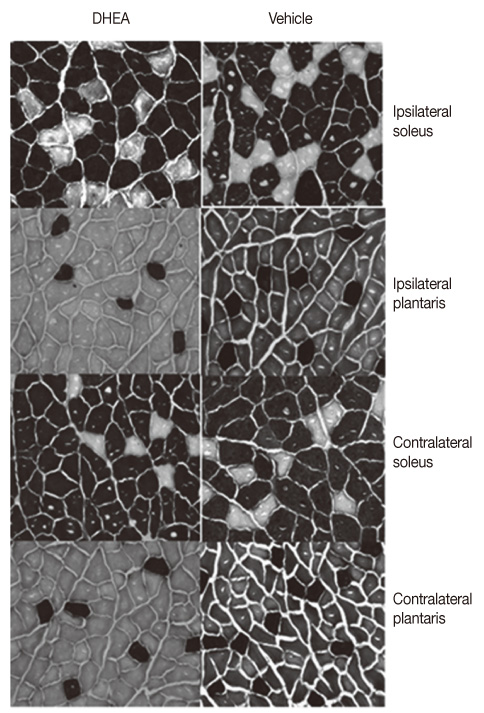
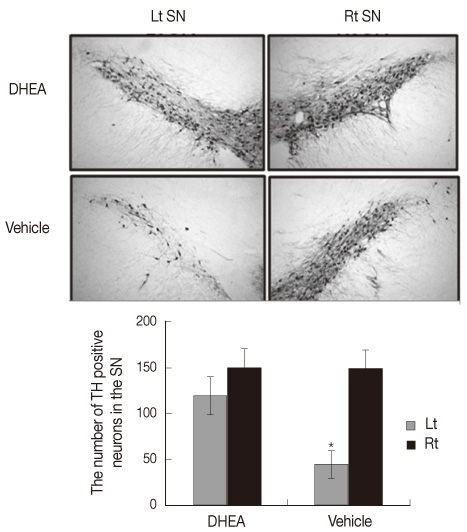
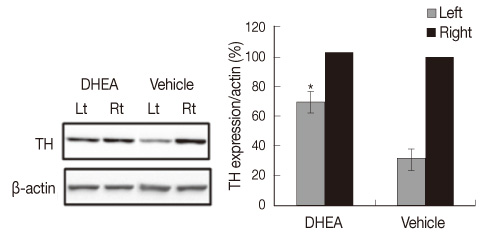
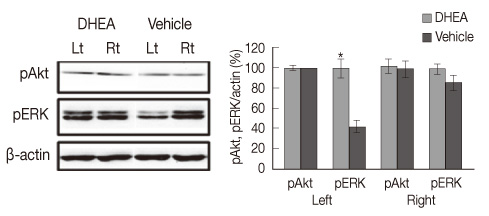


Figure & Data
REFERENCES
Citations

- Therapeutic potential of enzymes, neurosteroids, and synthetic steroids in neurodegenerative disorders: A critical review
Refik Servi, Ramazan Fazıl Akkoç, Feyza Aksu, Süleyman Servi
The Journal of Steroid Biochemistry and Molecular Biology.2025; 251: 106766. CrossRef - Neuroactive Steroids, Toll-like Receptors, and Neuroimmune Regulation: Insights into Their Impact on Neuropsychiatric Disorders
Irina Balan, Giorgia Boero, Samantha Lucenell Chéry, Minna H. McFarland, Alejandro G. Lopez, A. Leslie Morrow
Life.2024; 14(5): 582. CrossRef - Parkinson Symptom Severity and Use of Nutraceuticals
Laurie K. Mischley, Joshua Farahnik, Ludwig Mantay, Jamie Punzi, Kayla Szampruch, Tyrice Ferguson, Devon J. Fox
Nutrients.2023; 15(4): 802. CrossRef - Expression analysis and single-nucleotide polymorphisms of <i>SYNDIG1L</i> and <i>UNC13C</i> genes associated with thoracic vertebral numbers in sheep (<i>Ovis aries</i>)
Ying-Jie Zhong, Yang Yang, Xiang-Yu Wang, Ran Di, Ming-Xing Chu, Qiu-Yue Liu
Archives Animal Breeding.2021; 64(1): 131. CrossRef - Probiotic Supplementation Facilitates Recovery of 6-OHDA-Induced Motor Deficit via Improving Mitochondrial Function and Energy Metabolism
Bira Arumndari Nurrahma, Shu-Ping Tsao, Chieh-Hsi Wu, Tu-Hsueh Yeh, Pei-Shan Hsieh, Binar Panunggal, Hui-Yu Huang
Frontiers in Aging Neuroscience.2021;[Epub] CrossRef - Effects of Antioxidant on Reduction of Hindlimb Muscle Atrophy Induced by Cisplatin in Rats
Jin il Kim, Myoung-Ae Choe
Journal of Korean Academy of Nursing.2014; 44(4): 371. CrossRef




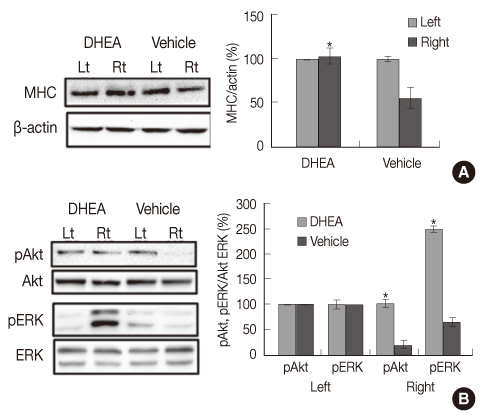
Figure 1
Figure 2
Figure 3
Figure 4
Figure 5
Pre-and Postexperimental Weight of Rats in the DHEA and Vehicle Groups
DHEA=Dehydroepiandrosterone.
Total Amount of Diet Intake, Weight Gain, and Total Activity Score during the Experimental Period
DHEA=Dehydroepiandrosterone.
Muscle Weight of the DHEA and Vehicle Rats
*Significantly different between DHEA & Vehicle group (p<.05). DHEA=Dehydroepiandrosterone.
Cross-Sectional Area of the Hindlimb Muscles in the DHEA and Vehicle Rats
DHEA=Dehydroepiandrosterone.
DHEA=Dehydroepiandrosterone.
DHEA=Dehydroepiandrosterone.
*Significantly different between DHEA & Vehicle group (
DHEA=Dehydroepiandrosterone.
 KSNS
KSNS
 E-SUBMISSION
E-SUBMISSION



 Cite
Cite

